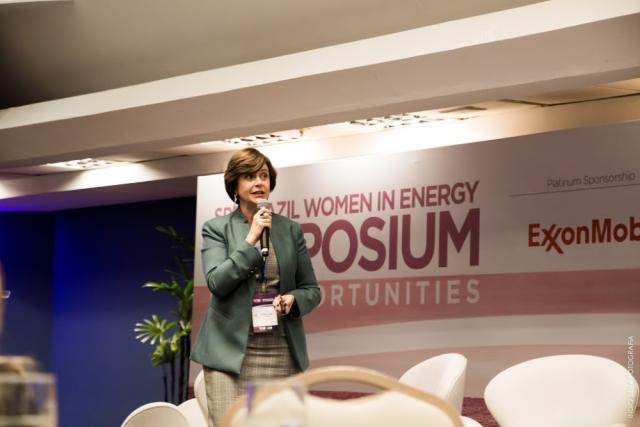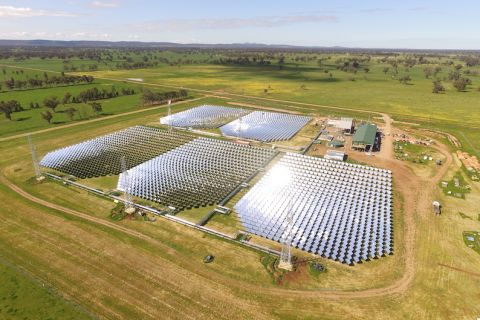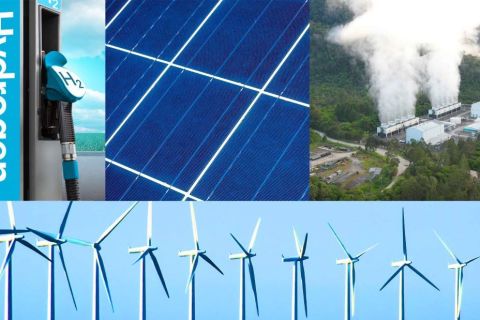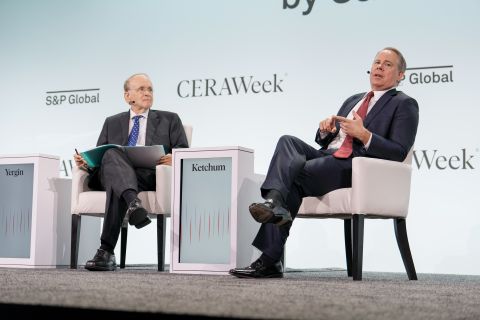
Petrobras Refining and Natural Gas Director Anelise Lara speaks at SPE Brazil's Women In Energy Symposium. (Source: SPE Brazil)
RIO DE JANEIRO— As the oil and gas industry faces challenges that include environmental concerns and the rise of renewable energy, gender diversity in the labor force remains a work in progress.
According to the Brazilian Institute of Geography and Statistics, despite some advancements seen over the past years, the representation of women in senior management positions accounts for only 39.1% nowadays.
To highlight diversity and the role of the women at oil companies in Brazil, the Society of Petroleum Engineers (SPE) Brazil held the Women In Energy Symposium: E&P Opportunities on July 18. The event, which brought to Brazil an agenda implemented in the U.S. by SPE, was designed and organized by SPE’s Women in Energy (WIN).
Exxon Brazil CEO Carla Lacerda, Chevron Business Development Director Patricia Pradal, Total R&D Director Isabel Waclawek and Petrobras Refining and Natural Gas Director Anelise Lara were keynote speakers at the event. They shared their experiences and challenges faced by women who work as leaders in the industry in Brazil.
“We are not there yet,” said Lara, former president of SPE Brazil. She said the situation has not changed much since she was hired by Petrobras in 1986. “Women were 10% of the company, which had 57,000 employees. Today there are 48,000 employees, but women represent 16% of all employees,” Lara said.
Lara also said Brazil’s oil and gas industry needs to have more female role models in the industry as a whole.
“We are going to experience a new moment in the downstream and natural gas areas, similar to what happened [in the] E&P segment. It is necessary to get excited, stimulate [and] inspire more women to participate in this market. See the future with many more executive women than men,” she said.
Shauna Noonan, who will lead SPE next year, recalled working as a drilling supervisor in Canada and being the only woman in the field. Today, she is aware of the advances of women in the industry, but she also said the industry is still far from seeing the equality that must be sought. For Noonan, as deepwater projects return to levels seen during the beginning of the decade and as digitization advances, more opportunities are opened for women in the industry.
“Industry 4.0 opens up new perspectives for women, as we can do so much more without having to move to other regions of the world, as it occurred in the past,” she said. “We must take advantage of these opportunities.”
Alejandro Duran, president of ABESPetro, the Brazilian Association of Oil Services Companies, pointed out that supplier companies have opportunities for women. “Women are a minority, and that needs to change. Not because it is good in terms of image, equity, but also for the sake of survival,” he said.
For Duran, the oil and gas goods and services industry must reinvent itself and diversity is one of the ways to achieve this goal. “We have engineers, biologists, geophysicists, many data analysts. What I miss is the ability to analyze from a different perspective,” he said. “Women can bring that. This diversity of point of view is what we need.”
ExxonMobil Brazil CEO Carla Lacerda agreed that opportunities exist for women in the industry. However, she noted that in her 30-year career at Exxon Mobil, many things have to be done for a structured career for women in the industry.
“Times have changed,” said Lacerda, who graduated with a degree in oceanography. “I thought I would take the path of science and here I am, working for the oil and industry. This proves that several professionals have a place in this industry,” she said, adding that, in terms of diversity, her team is doing well in In Brazil. She said 40% of Exxon Mobil’s employees are women, and the rate is higher among executive posts.
Total’s Waclawek took a similar path, leaving a career as a computer analyst to enter the oil and gas industry. She saw an opportunity to work as a R&D expert for Petrobras Research Center ten years ago. Today, she is in charge of Total’s R&D efforts. “Diversity is natural here,” she said.
Recommended Reading
Energy Transition in Motion (Week of Jan. 26, 2024)
2024-01-26 - Here is a look at some of this week’s renewable energy news, including NextEra Energy’s growing renewable energy backlog.
Could Concentrated Solar Power Be an Energy Storage Gamechanger?
2024-03-27 - Vast Energy CEO Craig Wood shares insight on concentrated solar power and its role in energy storage and green fuels.
Energy Transition in Motion (Week of March 1, 2024)
2024-03-01 - Here is a look at some of this week’s renewable energy news, including Chevron’s plans for a solar-to-hydrogen facility in California.
CERAWeek: NextEra CEO: Growing Power Demand Opportunity for Renewables
2024-03-19 - Natural gas still has a role to play, according to NextEra Energy CEO John Ketchum.
Energy Transition in Motion (Week of March 8, 2024)
2024-03-08 - Here is a look at some of this week’s renewable energy news, including a record-setting 2023 for U.S. solar.




